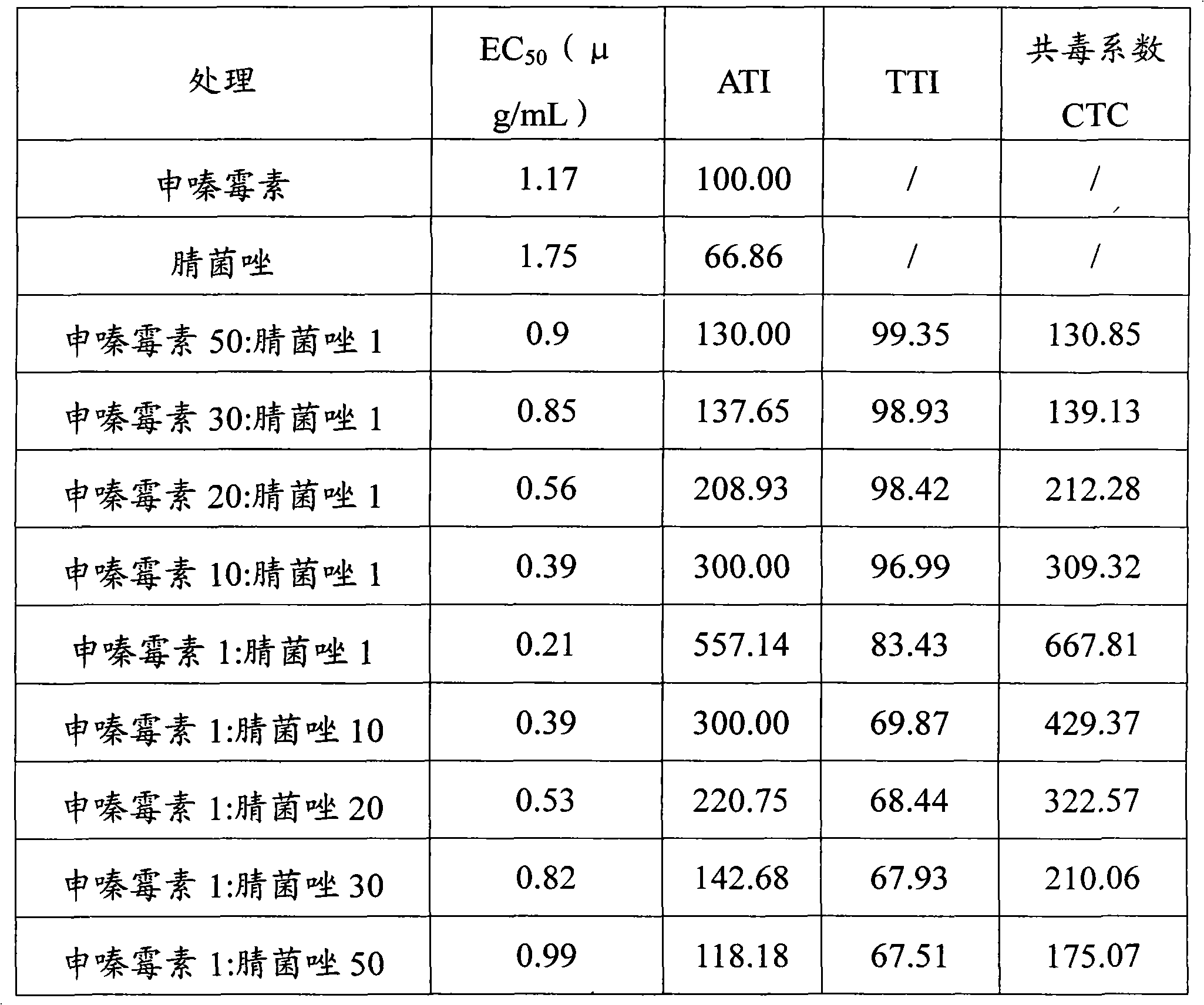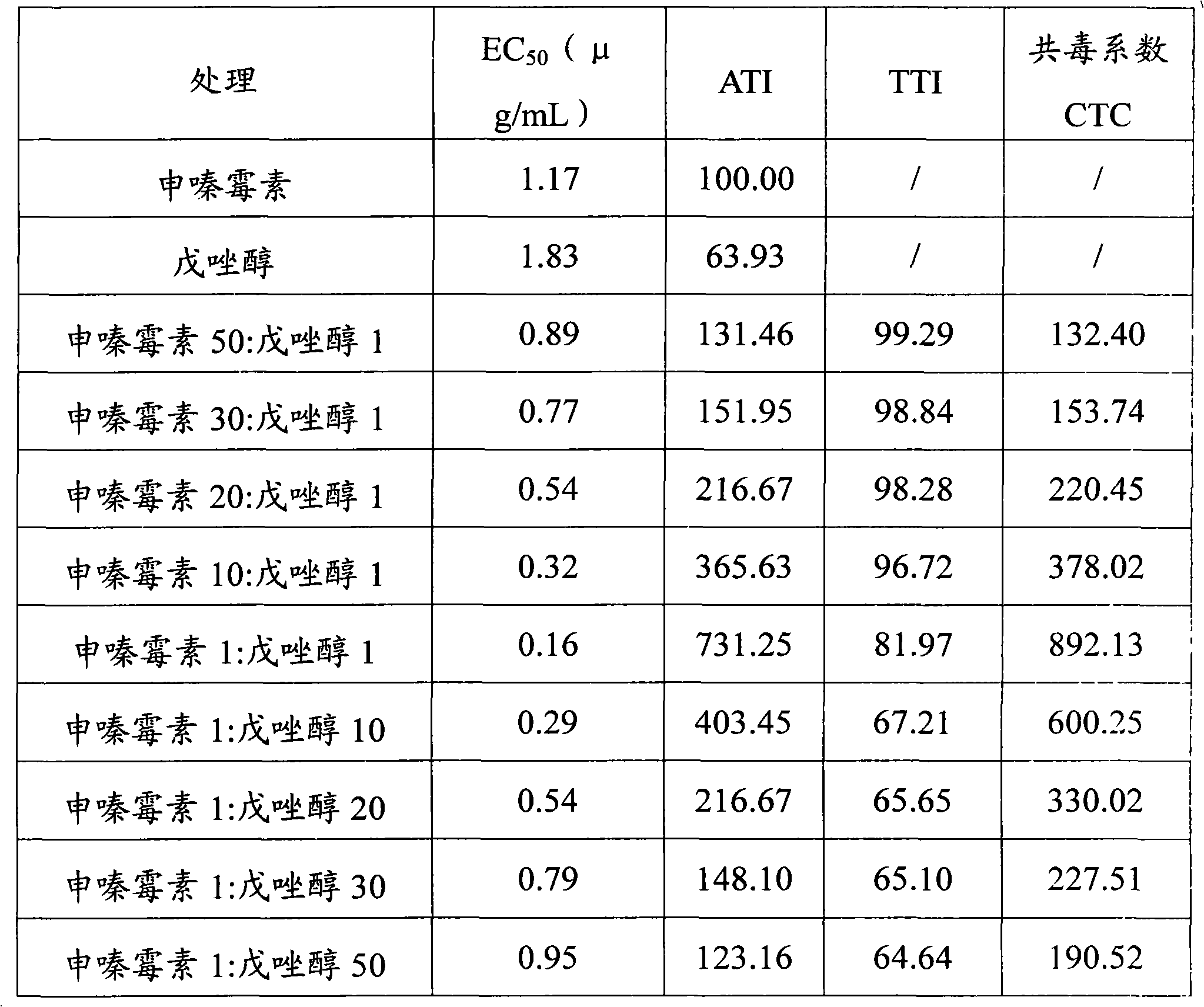Sterilization composite based on phenazino-1-carboxylicacid
A technology of shenzimycin and its composition, which is applied in the field of agricultural fungicidal compositions containing shenzimycin, and can solve the problems that the combined application of shenzimycin and triazoles has not been reported.
- Summary
- Abstract
- Description
- Claims
- Application Information
AI Technical Summary
Problems solved by technology
Method used
Image
Examples
example 1
[0024] Bioassay Example 1: Indoor Toxicity Determination of Shenzimycin and Propiconazole Compound to Rice Sheath Blight
[0025] Test object: Rice sheath blight (Rhizoctonia solani), collected from the field, separated and purified indoors.
[0026] Test method: refer to the "People's Republic of China Agricultural Industry Standard NY / T1156.2-2006", that is, the mycelium growth rate method. Dissolve the original drug with acetone, dilute with 0.1% Tween 80 water, and prepare 6 series of mass concentrations. Under sterile conditions, take 5 mL of the prepared medicinal solution and mix them with 75 mL of culture medium evenly to make 4 plates containing medicine, and mix an equal amount of sterile water with the culture medium as a control. Under aseptic conditions, the cultured cucumber blight was cut out from the edge with a sterilized puncher with a diameter of 5 mm. Use an inoculator to inoculate the fungus cake on the center of the drug-containing plate, with the mycel...
example 2
[0035]Bioassay Example 2: Indoor Toxicity Determination of Shenzimycin and Hexaconazole Complex on Rice Sheath Blight
[0036] Test object: Rice sheath blight (Rhizoctonia solani), collected from the field, separated and purified indoors.
[0037] Test method: refer to the "People's Republic of China Agricultural Industry Standard NY / T1156.2-2006", that is, the mycelium growth rate method. The test method is the same as that of biological assay example 1, and the least square method is used to calculate the inhibitory intermediate concentration EC50, and then the co-toxicity coefficient (CTC) is calculated according to Sun Yunpei's method. When CTC120, the composition exhibits synergistic effect.
[0038] Actual Toxicity Index (ATI) = (standard drug EC50 / test drug EC50) × 100
[0039] Theoretical toxicity index (TTI) = Toxicity index of agent A × percentage of A in the mixture + toxicity index of agent B × percentage of B in the mixture
[0040] Co-toxicity coefficient (CTC...
example 3
[0044] Bioassay Example 3: Indoor Toxicity Test of Shenzimycin and Difenoconazole Compound on Rice Sheath Blight
[0045] Test object: Rice sheath blight (Rhizoctonia solani), collected from the field, separated and purified indoors.
[0046] Test method: refer to the "People's Republic of China Agricultural Industry Standard NY / T1156.2-2006", that is, the mycelium growth rate method. The test method is the same as that of biological assay example 1, and the least square method is used to calculate the inhibitory intermediate concentration EC50, and then the co-toxicity coefficient (CTC) is calculated according to Sun Yunpei's method. When CTC120, the composition exhibits synergistic effect.
[0047] Actual Toxicity Index (ATI) = (standard drug EC50 / test drug EC50) × 100
[0048] Theoretical toxicity index (TTI) = Toxicity index of agent A × percentage of A in the mixture + toxicity index of agent B × percentage of B in the mixture
[0049] Co-toxicity coefficient (CTC) = [...
PUM
 Login to View More
Login to View More Abstract
Description
Claims
Application Information
 Login to View More
Login to View More - R&D
- Intellectual Property
- Life Sciences
- Materials
- Tech Scout
- Unparalleled Data Quality
- Higher Quality Content
- 60% Fewer Hallucinations
Browse by: Latest US Patents, China's latest patents, Technical Efficacy Thesaurus, Application Domain, Technology Topic, Popular Technical Reports.
© 2025 PatSnap. All rights reserved.Legal|Privacy policy|Modern Slavery Act Transparency Statement|Sitemap|About US| Contact US: help@patsnap.com



